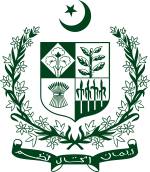2018–19 Pakistan federal budget
 | |
| Presented | 28 April 2018 |
|---|---|
| Parliament | National Assembly of Pakistan |
| Party | Pakistan Muslim League (N) |
| Finance minister | Miftah Ismail |
| Treasurer | Ministry of Finance |
| Total revenue | |
| Total expenditures | |
| Debt payment | |
| Deficit | |
| Website | Budget Brief |
|
‹ 2017–18 | |
The Federal budget 2018–19 is the federal budget of Pakistan for the fiscal year beginning from 1 July 2018 and ending on 30 June 2019.[1] The budget was presented by finance minister Miftah Ismail on 28 April 2018, just months before the general elections scheduled in the country for the next government.[1]
The budget announced several measures; including an allocation Rs. 1,100 billion for defence expenditures; a ten percent hike in salaries and pensions of civil and military employees; a health tax enforced on tobacco and import taxes on cell phones; around Rs. 2.22 trillion were to be used for debt servicing; changes were made to the progressive taxation system, with no taxes to be deducted on people with annual incomes of up to Rs. 400,000; Rs. 25 billion were allocated for the health and medical sector under the Public Sector Development Programme, which would include several new projects;[1] tax cuts were announced for the agriculture and dairy farming sectors; another Rs. 2.6 billion were announced for the National Accountability Bureau, which include employee expenses; all provinces were to get a total of Rs. 2.59 trillion as part of their share in the federal revenues; Rs. 18.2 billion would be spent on the fencing of the Afghanistan–Pakistan barrier on the border;[1] Rs. 130 billion worth of additional levies were slapped on petroleum products;[1] and finally, smaller expenses were announced for setting up a media development and television monitoring system. The budgets for the President and Prime Ministerial residences, borne out of tax-payers funds, had also risen notably.[1]
References
- ^ a b c d e f "Here is all you want to know about Budget 2018-19". The News International. 28 April 2018. Retrieved 9 September 2018.
